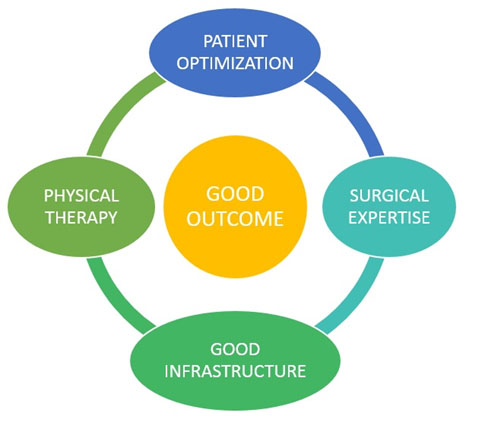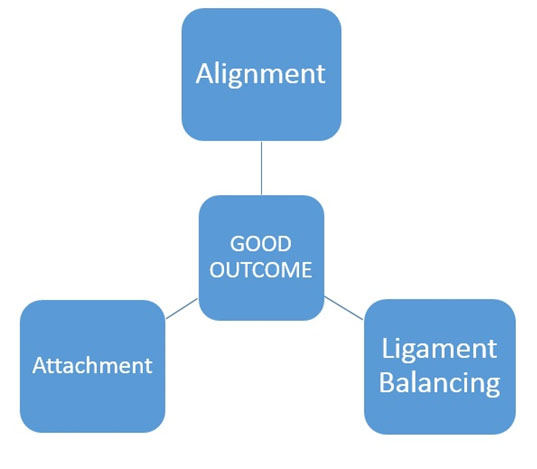Book Appointment
Fillup the form to make an appointment with the doctor
Total Knee Replacement Why Us for TKR?
This is a fundamental question which most patients ask when undergoing treatment. Patients typically meet more than one surgeon and sometimes up to 4-5 for clarification, pricing for the procedure, and outcomes. Given the practice pressure and like in all competition, some people promise unrealistic results, and patients are disappointed with the outcome after paying a high cost for their surgery. It is generally true that doctors pick a particular design based on their training, the ability of the companies to deliver the implants on time, and their service. Surgeons understanding of knee kinematics and how a particular design helps in accomplishing those goals also helps in determining the implant choice. The recent price capping has been a boon in the sense that surgeons are free to pick a particular implant without the worry about the high cost of the prosthesis. Still, there are concerns regarding designs and their influence on the outcome

In a country like India where health care is not strictly regulated, medical education has shifted to the private sector, and profit has been the primary motive for many organizations- patients find it extremely difficult to make “informed choices” regarding their care. Unfortunately, joint replacement is an expensive procedure, sometimes costing as much as the annual income of the entire family. We have thus made an effort to simplify the science behind arthritis, the art behind the surgical procedure, and the commerce behind the current practice of arthritis care.
Our surgeon has been trained in a large academic set up and has knowledge & experience in performing a total joint surgery (Please visit our doctor section to look at the doctor details). He has done a certified Adult Reconstruction Surgery fellowship from the State University of New York. The fundamental difference between a fellowship certified surgeon and a general orthopedic surgeon is the ability to deal with complexities and supervised training. During a certified fellowship (unlike many visiting fellowships) a surgeon is assessed by a group of senior mentors who assess the surgeon on various parameters. They finally certify the trainee saying that the individual can deal with the mentioned problems, and only then does a university grant a diploma to that individual. A surgeon spends dedicated time performing accurate surgeries, understanding the intricacies of implants available, alternate surgical procedures, and revising joint replacements. The aim of the fellowship training in western set up is to improve the quality of patient care, and we attempt to replicate the same quality of care here in India.
Innovation today has reached a point where it is hard to differentiate the useful from the cosmetic as you can see in the illustration that there is an interrelationship in the process of innovation.
It begins with Quantum innovation by a few motivated individuals whose merits are apparent, and the techniques are adapted quickly. The quantum innovation in joint replacement started with people like John Charnley, whose missionary zeal laid the foundation of modern joint replacement. Incremental innovation begins when people begin exploring methods to improve existing prostheses and create designs and models that help in making improvements that help better patient outcomes. But, the biggest problem we face is the cosmetic innovation aspect of medicine. In joint replacements, there have been a large number of cosmetic innovation changes done by companies knowingly or unknowingly in the hope of improving outcomes. They have helped in enhancing profitability for companies and hospitals but mostly have not done much for patient outcomes. The problem for surgeons today is the ability to differentiate cosmetic from incremental innovation so that patients benefit. We promise to help you make an informed choice by being transparent in the decision-making process.
Good result after a joint replacement is determined by patient factors, some of which are correctable and some not, surgeon experience and the infrastructure. Each of them has a significant bearing on a joint replacement surgery.
Optimization is a relatively new concept in joint replacement, especially in the Indian context. Presently, patients are evaluated by surgeons and are immediately subjected to a joint replacement, which will significantly undermine the outcome for a knee replacement. An elective surgery like a knee replacement needs proper health optimization so that there can be a promotion of positive result after a knee replacement surgery

Mortality after the total knee is 1 in 500 patients, and even worse, the complication rate is 5.6%. Factors like Hypertension, Diabetes, Renal failure, Cardiac failure, Anemia, Thyroid problems are called co-morbidities, and according to a study done by Kreder et al. in the US, found that co-morbidities increased the mortality by 24 times. Therefore it is “absolutely imperative” that the patient’s health is evaluated and optimized where the effect of the co-morbidities is taken care of and thus reduces the risk of complications. Our surgeon lead team evaluates the patient and helps in optimizing the patient before undertaking joint replacement surgery. With multidisciplinary intervention for anemia correction, Hypertension, and Diabetes optimization and treatment of Urinary tract infection before the actual joint replacement where we treat the patient and not the diseased joint!
| Co-Morbidity | Relative Risk for PJI |
|---|---|
| Obesity (BMI>40) | 3.3 |
| Malnutrition ( Albumin < 3.5 g/dl) | 7 |
| Diabetes uncontrolled | 2.2 |
| Rheumatoid Arthritis | 1.18 |
| Smoking | 1.41 |
| Anemia | 2.15 |
The infrastructure in the hospital where we perform the joint replacements is exceptional. The setup is comparable to western standards and thus helps in the delivery of good results to the patients. Optimization is critical because the complications of joint replacement can be catastrophic to the patient. Infection prevention strategies, post-operative Physical Therapy, and rehabilitation play a significant role in patient outcomes.

Some surgeons claim to have perfect records with perfect outcomes and set unrealistic goals and claim certain implants or techniques have better results without adequate data support. On analysis of the cumulative failure of knee replacement over the last 30 years, there are a few factors that have known to have a bearing on the outcome of a TKR. The Major causes of Failure of total knee Replacement are Aseptic Loosening, Polyethylene wear, and infection.
The ALBA approach was devised to address these problems and have uniform good clinical outcomes for TKR. ALBA approach helps to prevent the complications by adhering to the principles of Joint replacement. The principles are proper mechanical Alignment of the Joint, Ligament Balancing, and Attachment of the prosthesis with proper cementing techniques. This attention to detail helps in ensuring that patients have a good outcome after joint replacement.

Alignment – This is achieved by using various mechanical, radiological, and navigation tools based on the clinical situation so that proper mechanical alignment is obtained during the seating of implants.
Ligament Balancing- Total knee arthroplasty is a “soft tissue surgery.” Even though it involves cutting of bones and fixing implants fundamentally, it involves balancing the ligaments (rope-like structures that hold the femur-thigh bone and tibia-leg bone together). The tissue balancing is done in the front and back of the knee as well so that the pressure on the prosthesis is uniformly distributed
Attachment- We use the “global compression technique,”- which essentially means that we are filling the circumferential gaps between the metal and bone with bone cement. The reason it is crucial is for the long term implant survivorship. Studies have shown that if the interfaces are not secured, there could be mid-term loosening. The joint replacement, which should typically last for about 15-20 years, might work loose earlier for lack of good fixation.
